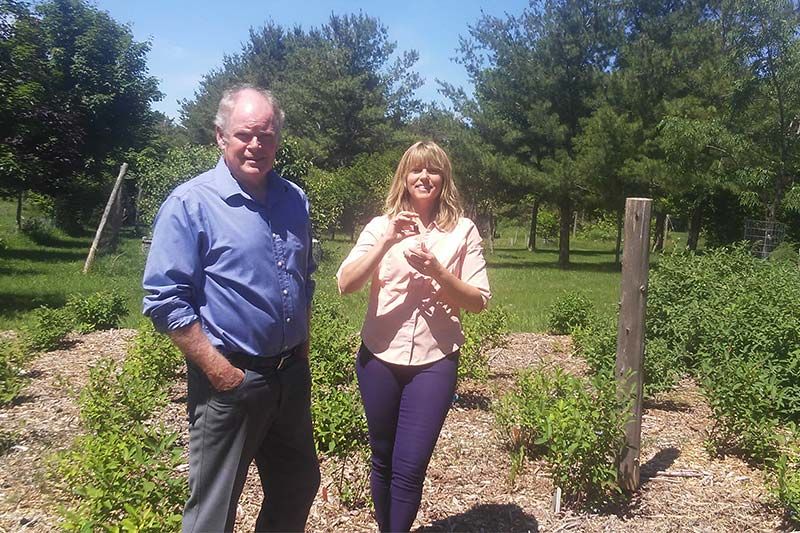Jul 12, 2017
Bob and Sue Clinton are well known in Sydenham for Bob’s biological dentistry practice and Sue’s efforts with the Loughborough Christmas Committee and other community efforts they both have taken on over the years.
While all of this has been going on, they have also been working on developing their small acreage near the village as an eco-friendly garden/orchard/permaculture space. They grow garlic in “beds” that are made of piles of bark and scrap fire wood, have altered the landscape to keep water on the property for their trees, grow different varieties of grapes, and are always reading up on new ways of growing organically. All of this searching has brought them to the Haskap berry, which has now has a prominent place on their property.
Haskap berries have gained popularity slowly across Canada. They are a blue, oblong berry. They are the colour of blueberries but larger, and their taste is unique, it is vaguely like a cross between a blueberry, a black currant and a raspberry. When they are ripe, they are soft and plump and not quite as sweet as a blueberry or a raspberry, but still full of flavour.
Blueberries are considered a super-food because they are rich in anti-oxidants, and Haskaps are even higher in ant-oxidants as well as being a good source of vitamin C and dietary fibre. They can be made into syrup, flavoured vinegars, jam, wine, liqueur, ice cream and any other use that spring and summer berries are used for. They freeze well, and can be tossed into smoothies just like frozen blueberries, strawberries or raspberries.
Over the last few years, the Clinton’s have taken to growing different varietals that come from the University of Saskatchewan, where work is being done to develop Haskap as a commercial berry in Canada.
It is the ease of growing Haskap’s, their flavour, and health benefits that originally attracted the Clinton’s. As became very clear when visiting in mid-June, they have become taken with everything about the berry.
They have several rows of plants, which bush out about three feet and grow about as tall as that as well.
“We have been at this for a few years and you can see by the plants that some are earlier than others, and the fruit varies as well,” said Bob
He pointed to a healthy row of smaller plants, new varieties developed in Saskatchewan. The plants take five years to mature, but even at a year or two old, they begin a limited yield of berries. These ones were bushing out well, had tons of new growth, and a pretty good haul of ripening berries.
“They are very easy to grow. We have had no winter kill with them, they seem to resist most insects. The only thing they really need is to be kept weed free. That’s why we use a lot of mulch with them,” he said.
Haskaps are like pear and plum trees in that there needs to be more than one variety planted in order for them to produce fruit, but they are essentially a very easy plant to grow in virtually all conditions in Southern Canada.
For home gardeners, like the Clinton’s, they are an ideal fruit.
“One of the other things I like about them is how early the fruit is,” said Sue. “They are earlier than strawberries, and it is easy to tell when they are ready because they literally fall off the stem.”
Commercial harvesters use equipment to shake the bushy plants, and the Clinton’s were planning to experiment with placing some form of tarp under the plants and then hand shaking them, to save on picking time.
In any case, when compared to hand picking other berries or currents, the uniformity of harvest and lack of barbs on the plants make Haskap a superior picking berry than just about all others that grow in this region, at least in the experience of this reporter.
The Clinton’s eat fresh Haskaps when they are fully ripe, and they freeze them as well. They haven’t made wine out of them, but they have purchased the liqueur, which is reminiscent of creme de cassis.
As a culinary berry, Haskap has an advantage over blueberries because it has the slight bitterness and depth of black currants, making the jams, wine, and liqueur superior.
“We find that it is a crop that is easy to grow, lasts a long time, does not spread, and produces a delicious berry that is very, very healthy. They would be a great addition to any garden, and hopefully a commercial industry will spring up in Ontario as well, maybe even in Frontenac County,” said Sue Clinton.
And for those interested in ordering and planting, it is not too late to start in 2017. Fall is the best time to transplant Haskaps.
The Clinton’s have been doing their own field testing, but they refer to information from Haskap.ca, the website of the Not-for-Profit Haskap Canada Association.
More Stories
- The Sun Shines On The Parham Fair
- Creating Your Own Weather, Forever and Ever
- Silver Lake Pow Wow Set For A Big Year
- South Frontenac Receives Substantial Provincial Grant for their Verona Housing Project
- South Frontenac Council Report - August 12
- Dumping To Be Curtailed At Loughborough Waste Site
- Central Frontenac Inching Towards Increasing Severance Opportunities
- Addington Highlands Council Report - August 12
- Addington Highlands Council Report - August 5
- Addington Highlands Council Report - August 12

